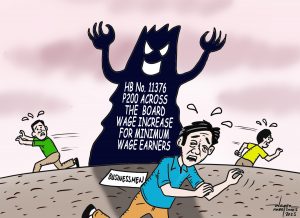THEe Davao City Sangguniang Panlungsod, in its session last week, approved an ordinance creating the Davao City Inventions and Innovations Council (DCIIC). The local legislation was authored by councilor Pilar Braga of the First District and we believed it was crafted with large input from her consultant Wennie Gorres, undoubtedly a workhorse of a person.
The Council when constituted, will be responsible in helping Davao inventors and innovators have their work collated by the local government, proto-typed, assisting inventors and innovators process their application for acquiring intellectual rights or patent, producing and eventually marketing.
The problem that consultant Wennie is foreseeing is how to operationalize the council. That is why he is seeking comments, reactions and recommendations from stakeholders through meetings in various virtual platforms like Zoom.
We believe fully in Wennie’s concern. The problem really of many local legislations creating this and that body for the purpose of undertaking support activities for the city’s governance is that more often than not the most important component of the creation of the body is absent or simply taken for granted. In the process the output body becomes ad hoc and thus dependent on the support of other departments or offices of the local government.
For example in his call for reactions and inputs from stakeholders on crafting a process for the operationalization of the DCIIC Wennie failed to mention whether the ordinance also provides for a regular budget for its annual requirement when it is operating.
Has the same local legislation created a plantilla for the various positions of personnel that will run it and also includes the necessary budget for salaries of personnel and for its maintenance and other operating expenses?
If not, then we could only assume that this very significant piece of legislation would just be another item “in aid of reelection” for the proponent if still allowed under the law, or “in aid of election” to any of his/her endorsed candidate to take her place. The latter process, we have observed, has already become the norm among politicians these days.
But as we said earlier the creation of a DCIIC is one important piece of legislative work and its intentions is definitely noble. So, we are hopeful that this ordinance will not end up wasted and becomes a mere piece of paper soon to be hidden in the moist-laden and dark recesses of the Sangguniang Panlungsod archive.
****************************
A few days ago a friend of ours on Facebook Marlu Villarosa, whom we have yet to meet personally, shared to us his gut feeling on the apparent gains of Davao City as far as its fight against the dreaded CoViD 19 is concerned.
As many Davaoenos and others living outside of Davao City, have observed in the past months, Davao was suddenly lost in the radar of the continuing monitoring of places with high infection rate especially after the apparent surge in the National Capital Region (NCR) We share with Marlu’s observation and we are extremely happy over the development even if we know that there are not much visible actions done by the LGU to deter the pandemic.
In fact we assume that the sign of success in the fight against the virus in Davao City was manifested by the suspension of the use of the Food and Medicine Pass (FM Pass) which to us was one effective way of controlling the number of people going outside their residence on any day. In other words the number of those allowed on the streets, malls, public markets and other establishments were effectively distributed on a reduced basis since under the FM Pass rule only pass holders with allowed last digit for a particular day can go out and do their activities which are regulated as well.
But we also believed that our friend Marlu has some points in his tinkering of the idea that the sudden “disappearance” of Davao City in the radar of top five places with most CoViD infections daily may not be totally the real picture.
He said he is curious as to where the city really stands now in the infection rate level because there was no extraordinary strategy being implemented. He cited a similar observation of ours, that quarantine checkpoints are no longer manned, more people are already going out freely, in some instances and occasions, there are people disregarding wearing of face mask and face shield, and social distancing rule is often disregarded.
So, where does the success in the fight come from? Despite all these however, our friend conclude, as we do, that the gains are attained. That is why he is apprehensive and entertains some doubts as to the legitimacy of the Davao CoviD situation.
Apparently though the local government is not basking on this achievement, if at all it is. The city has made necessary preparations for any possible surge. From what we learned lately, the mayor is requesting the national anti-CoViD Task Force to ask local government executives in the Davao Region to place their borders on semi-closed status to prevent easy-movement of people from one province or city to another. The mayor sees the scheme as most effective measure in slowing or preventing transmissions as the potential virus carriers can be checked of their tracks.
This move would surely calm down anybody’s apprehension on the present state of Davao City in its place in the struggle against the deadly virus. Hopefully…




